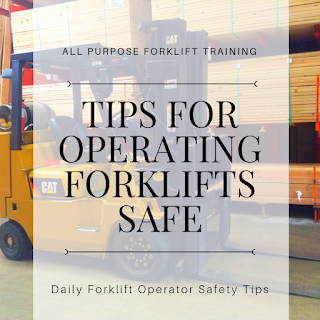Operating Forklifts Safe in the Workplace
Here are some Tips on Operating Forklifts Safe for Daily Forklift Jobs:Load Distribution
Load supply is a vital factor to safely operating any forklift. Every make and model of forklift has a different load capability and it is crucial that forklift operators are conscious of the ability and the best way to make sure loads are distributed effectively. Shape size, position, and weight distribution are factors to take into account when calculating whether loads are distributed and if lifts could safely be executed. Overloading a forklift may lead to even the loading, the back wheels raising, steering control malfunctions or the machine learning falling off the forks. Any load supply mistake may result in accidents that have the capacity to result in severe injury. When operating a forklift always consider load distribution. Find out more.Suitable Preparation
Suitable preparation is needed for any septic operator. Operators should be sure to dress appropriately: like hard hat needed per business policies and ecological factors, hi-visibility jacket, safety shoes or any safety gear. Loose clothing should be avoided to prevent clothing interfering with controllers and becoming caught on the truck. Hands and shoes should be not oily and dry in order to avoid developing an accident and sliding controls off. Operators should make sure that mirrors, all controls, and seating are corrected and are within easy reach of the operator. Forklifts should never be worked unless the driver is seated in the designated operator's seat and all of the ligaments are inside the confines of the truck. Safety belts should be fastened through surgery. Machines should be switched off while recharged/refueled and refueling should occur in locations.Visibility
Maintaining clear visibility is a must in order to safely operate a forklift. To guarantee visibility that is forward, operators can take a lot. Operators are encouraged to make sure there is adequate visibility when placing a load and also to run equipment in reverse when a load restricts visibility. Operators may need another person to help or must otherwise confirm it is safe to move if visibility is blocked.Gear Inspection
Forklifts should be inspected for security regularly, per industry regulations and standards. The Occupational Safety and Health Administration (OSHA) provides checklists for forklift inspections. The checklists are provided as a member of OSHA's ongoing attempt to assist workers and employers in ensuring that a safe and healthful workplace is provided, as stated by the OSHA site. The lists function as a guide and may not be totally inclusive. Every sort of powered industrial truck is both exceptional and checklists relevant to every sort of vehicle ought to be altered. It is recommended that the manufacturer's instructions on automobile maintenance and owner's and operator's duties be consulted. Read the checklists.Hazard Avoidance
An obvious way to securely operate forklifts is to avoid all known dangers. Operators only operate equipment in areas that are designated and should follow all job website policies. All warning signs must be observed and security should stay a precedent. Operators stay aware of the environment and must always look in the direction of surgery. Since load stabilization may be impacted forklifts shouldn't be pushed over materials, holes and also bumps. Additional caution is needed when floors are obstructed or wet. When in the proximity of corners, exits, entrances, stairways, doors, and famous pedestrian walkways, operators should decrease speed and utilize warning programs.Environmental Factors
Operators should always be conscious of load peaks and heights of almost any entrances/exits. Extra precaution ought to be taken when operating equipment on ramps/bridges. Operators should always ensure that ramps/bridges have the capacity to withstand the weight of this load and machine. A safe distance away from edges should be maintained to avoid harm, accidents and load loss. All signs regarding clearance height and maximum floor weight ought to be observed with attention.Rate
Forklift operators should operate machines safely, abiding by all rate constraints and taking responsible action if necessary. Turns and corners should be taken with additional precaution and especially slowly. Sudden stops, turns or starts should always be avoided.Operator Qualifications
To prevent a hazard and/or harm, only those who have been trained, authorized and accredited should operate forklifts.Forklift Training and Certification School locations
All Purpose Forklift Training also provides aerial lift training as well as certification. For more information regarding free quotes and information please contact us at 888 501-1355 so we can assist you better. Thank you.
Read Article: How to Get Forklift and Scissor Lift Training
Read Article: How to Get Forklift and Scissor Lift Training

Thank you so much for sharing such an valuable content with us. Safety tips given here are really useful. For Forklift Licence Brisbane, contact us. It would be pleasure to help.
ReplyDelete